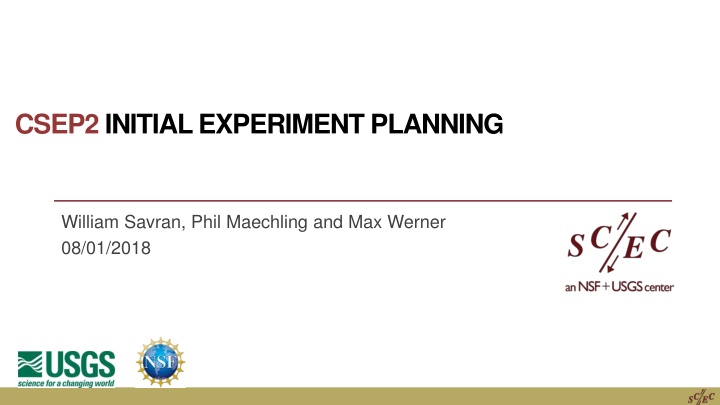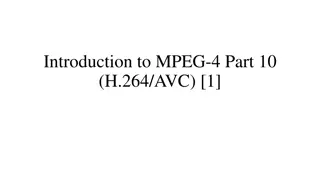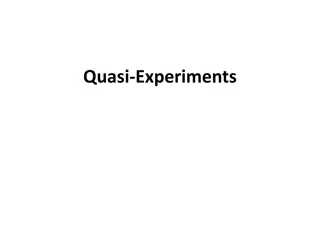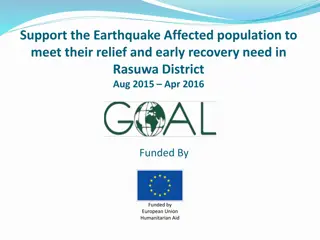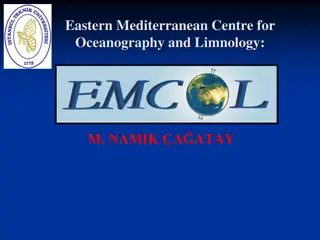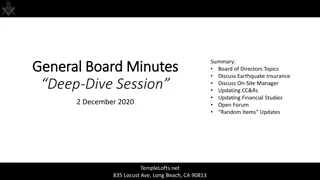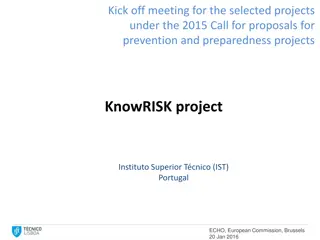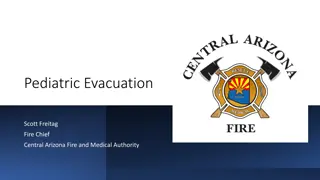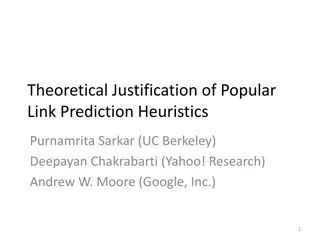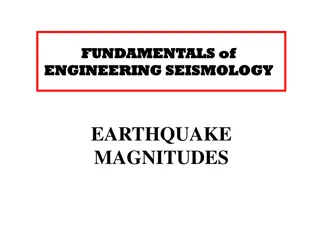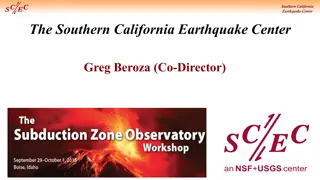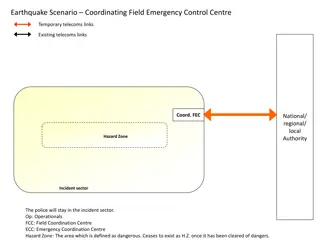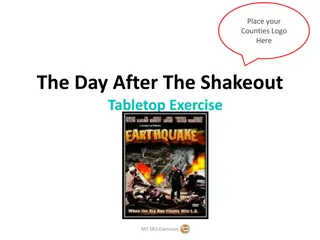Advancing Earthquake Prediction with CSEP2: Principles, Experiments, and Collaboratory
Explore the pivotal planning and design concepts behind the Collaboratory for the Study of Earthquake Predictability (CSEP). Discover the guiding principles of CSEP2, objectives for experiment planning, and the framework for testing regions and centers. Delve into the roadmap for community-driven developments and the prioritization of forecasting experiments based on scientific merit and societal impact.
Uploaded on Oct 08, 2024 | 1 Views
Download Presentation

Please find below an Image/Link to download the presentation.
The content on the website is provided AS IS for your information and personal use only. It may not be sold, licensed, or shared on other websites without obtaining consent from the author.If you encounter any issues during the download, it is possible that the publisher has removed the file from their server.
You are allowed to download the files provided on this website for personal or commercial use, subject to the condition that they are used lawfully. All files are the property of their respective owners.
The content on the website is provided AS IS for your information and personal use only. It may not be sold, licensed, or shared on other websites without obtaining consent from the author.
E N D
Presentation Transcript
CSEP2 INITIAL EXPERIMENT PLANNING William Savran, Phil Maechling and Max Werner 08/01/2018
Call Agenda(maximum 2 hours) Brief introductions Objectives CSEP2 principles Plans for CSEP2 experiments Discussion
Objectives Present roadmap for CSEP2 developments based on community inputs. Share proposal for initial CSEP2 experiments that encompass expected needs for CSEP2. Solicit feedback and identify working groups to define inputs for specific experiments (handled during working group calls or via e-mail).
Collaboratory for the Study of Earthquake Predictability (from Jordan et al., 2011) CSEP contains the following components: Testing regions: natural laboratories comprising active fault systems with adequate, authoritative data sources for conducting prediction experiments. Testing centers:facilities with validated procedures for conducting and evaluating prediction experiments. Communication protocols:procedures for conveying scientific results and their significance to the scientific community, government agencies responsible for civil protection, and the general public. Community standards: rules for the registration and evaluation of scientific prediction experiments.
Guiding Principles of CSEP CSEP2 developments will uphold the principals of CSEP1. Transparency Reproducibility Comparability Controlled Environment Developer time will be prioritized to maximize science over software developments. In other words, software infrastructure developments will not inhibit advancement of science. In order to honor our funding sources and maintain international collaborations, we will not encourage a shared-developer model between testing centers. However, we will strive to maintain system interoperability between testing centers. This approach has proven successful in numerous large-scale open source projects and leads to best-practices.
CSEP2.0 Design Concepts 1. CSEP2 infrastructure will be designed around the concept of forecasting experiments. 2. Experiments are a scientific procedure undertaken to make a discovery, test a hypothesis, or demonstrate a known fact. 3. Forecasting experiments can be either prospective or retrospective. 4. Experiments are defined by the scientific community and will run within CSEP testing centers to uphold the principles of CSEP. 5. Experiments will be prioritized based on their scientific merit and societal value. 6. Eventually, individuals could design and conduct their own forecasting experiments; however, their results would not be represented within the official CSEP data repository.
CSEP2.0 Software Principles 1. Support for models that run within Linux environment written in arbitrary computing languages 2. Must retrieve catalogs from external data sources (e.g., ComCat) 3. Controlled environment guaranteed by using virtual environments (e.g., containers) 4. Experiments will be represented as DAGs to ensure reproducibility and generality of CSEP experiments 5. Official CSEP experiment results will be managed in a controlled data repository 6. Eventual support for accepting external forecasts. Need to determine how to uphold CSEP principles 7. Design should accommodate existing codes to prevent duplicated developments (e.g., routines for working with fault-based forecasts)
CSEP2 Short-term Roadmap Start CSEP2.0 developments using experiments that cover the expected basic operations of CSEP2 and can be implemented immediately. Priorities are to test UCERF3 and candidate USGS aftershock forecasting models. By end of year (2018) we will have CSEP2 experiments running to address useful scientific questions.
Initial models to consider in CSEP2 1. U3ETAS 2. U3ETAS-NoFaults 3. FastETAS 4. Reasenberg & Jones Considerations were based on community responses (Powell Center and questionnaire) Must consider the comparability of these forecasts
Designing Experiments From a software perspective, all experiments are similar. The differences arise from scientific choices made during experiment design. Experiments Require: - Responsible Scientist(s) - Hypothesis/Scientific Question - Type (Retrospective or Prospective) - Forecasts - Experiment schedule - Spatial region - - - - Forecast horizon Input data Expected outputs Testing data source (could be simulation e.g., RSQSim or UCERF3- TI) Evaluations methods -
Designing CSEP2 Experiments Need input from scientific community defining specifics of CSEP2 experiments. 1. 2. 3. Identify two valuable questions to address by end of year 2018 Identify working group members (Offline) Drafting experiment specifics to present at CSEP workshop @ SCEC annual meeting Proposed Questions for discussion: 1. Does including faults provide additional value for UCERF3-ETAS forecasts? If so, in which situations are including faults necessary (quiet periods vs. active periods, proximity to faults, etc.)? 2. Is forecasting skill correlated with model complexity for short-term forecasts? In other words, do more complex models such as UCERF3-ETAS produce more skillful forecasts during large California earthquake sequences than simple models like FastETAS?
